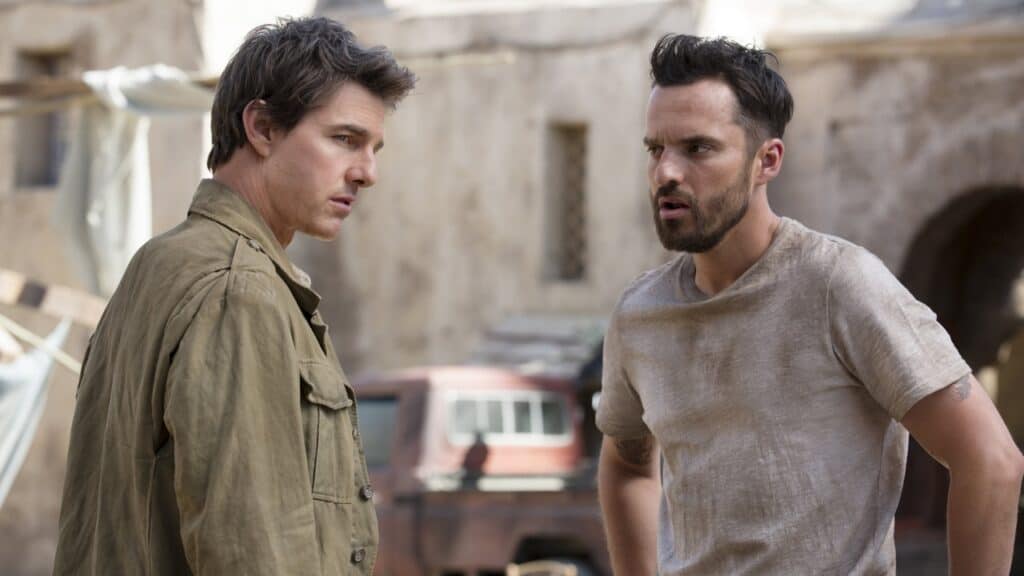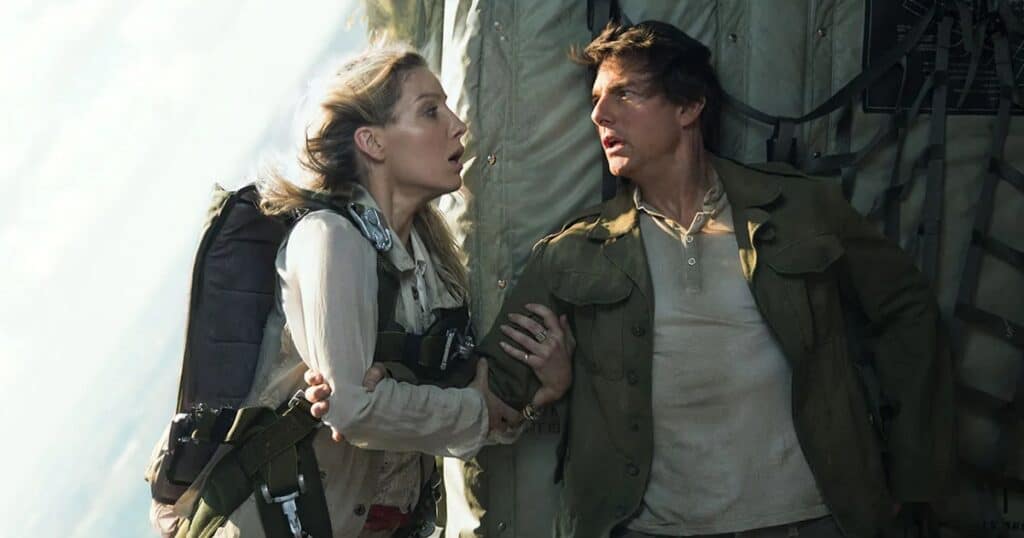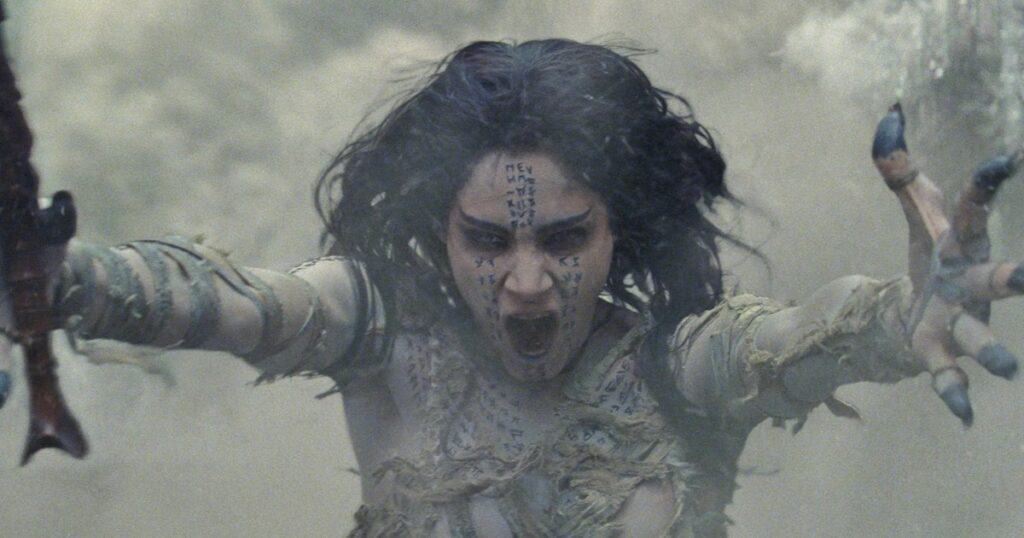
Universal Studios intended to build a cinematic universe with reboots of their classic Monster properties: the Dark Universe. A series of connected creature features, starting with a new version of The Mummy (watch it HERE), a big budget adventure film led by Tom Cruise. It sounds like a success story in the making, but something went wrong on the way to the screen. The Mummy was a financial failure, poorly received by critics and movie-goers alike. The Dark Universe was dead on arrival. So let’s look back at this bungled attempt at creating a cinematic universe and find out What the F*ck Happened to The Mummy.
The Mummy franchise started in 1932 with a film that starred the legendary Boris Karloff. He played Imhotep, an Ancient Egyptian high priest who was buried alive for attempting to resurrect the love of his life. Returned to life thousands of years later, Imhotep comes to believe a modern woman may be the reincarnation of his lost love. Universal made five more Mummy movies over the next couple decades… and while Imhotep ditched his bandages early on, the other mummies remained shambling, bandage-wrapped creatures throughout. Jump ahead to 1999. Universal revived the Mummy franchise with a blockbuster hit that starred Brendan Fraser as adventurer Rick O’Connell and Arnold Vosloo as Imhotep. Rick fought Imhotep again in 2001’s The Mummy Returns – a film that also spawned the spin-off franchise The Scorpion King. And in 2008, Rick battled another mummy, this one played by Jet Li, in The Mummy: Tomb of the Dragon Emperor. Although Dragon Emperor wasn’t as popular as its predecessors, Universal was initially planning to make another sequel. Having battled Egyptian and Chinese mummies, Rick would next take on a South American mummy in a film titled Rise of the Aztecs. There was even talk of Antonio Banderas playing the villain this time around.
But the same year Dragon Emperor was released, there was a shift in the blockbuster landscape. 2008 was when the Marvel Cinematic Universe got started with Iron Man. As Marvel built this series of connected superhero movies, assembling the Avengers, other studios started looking for ways to build their own cinematic universes. And that’s when Universal realized they could reboot their old Monster movies with films that would be connected to each other and full of crossovers. After all, that’s how the studio had made them the first time around. Standalone films like Dracula, Frankenstein, and The Wolf Man led to crossover movies where the monsters shared the screen. Then they were all introduced to the Abbott and Costello comedy duo as well.
This new endeavor would be called the Dark Universe. But how would they get it started? Would they build upon the success of the Brendan Fraser Mummy movies? Nope. Rise of the Aztecs was scrapped. Universal hired Jon Spaihts, who worked on the Alien prequel Prometheus, and The Hunger Games screenwriter Billy Ray to write competing drafts of a Mummy reboot. Maybe one script would be more worthy of going into production than the other, or maybe they’d just blend the finished scripts together into one. Star Trek reboot writer Alex Kurtzman was hired to produce The Mummy and develop a reimagining of Van Helsing. Underworld director Len Wiseman was attached to direct The Mummy at one point. When he stepped away, the job went to Mama director Andy Muschietti. The idea was that this Mummy would be darker in tone than the Fraser films, but still aimed at viewers of all ages. As development went on, it became clear that this would be more of an adventure movie than a horror movie. So Muschietti bailed. That’s when Kurtzman stepped up to direct the film as his second feature, following the drama People Like Us. Around that time, Universal also brought their Fast and Furious franchise writer Chris Morgan into the Dark Universe. Kurtzman and Morgan were to mastermind the entire series. Universal was going all-in on this. There would be reboots of Frankenstein, Bride of Frankenstein, The Invisible Man, The Wolf Man, Phantom of the Opera, The Hunchback of Notre Dame, Creature from the Black Lagoon. All of the classics were coming back.
They weren’t quite sure if their 2014 release Dracula Untold should be part of the Dark Universe, though. Reshoots were done to open the door to this possibility. Just in case. But once Dracula Untold was released, they decided, no, it wasn’t a Dark Universe movie. The Mummy would get this party started.

The Dark Universe would run on star power. This became evident when Tom Cruise, who had worked with Kurtzman on Mission: Impossible 3, signed on to star in The Mummy. And you don’t cast Cruise in your potential blockbuster to read the lines from an existing script. He’s going to bring some big ideas to the table, and he’s going to get some degree of creative control. Since Kurtzman had little directing experience, it’s been no surprise to hear that he struggled with the scope of the film during production. So Cruise took on nearly complete creative oversight. Sources told Variety, “it felt more like Cruise was the real director, often dictating the major action sequences and micro-managing the production”. And his control carried on into post-production, when he brought in his own editor.
Although Jon Spaihts retains a story credit on the finished film, Kurtzman also worked on the script. So did Rachel Getting Married writer Jenny Lumet, Jurassic Park writer David Koepp, Cruise’s frequent collaborator Christopher McQuarrie, and McQuarrie’s pal Dylan Kussman, who is best known as an actor. There were probably some uncredited script doctors in the mix as well. Here’s where problems begin to emerge. Not only was Universal rushing into the idea of a shared universe, but there were also too many cooks in the Mummy kitchen.
One draft of the script was said to involve a Navy SEAL named Tyler Colt, who battles mummies led by Ashurbanipal – a real historical figure – during a mission in Iraq. It was during the Lumet rewrite that the villainous mummy became a female character to be played by Sofia Boutella. She is Ahmanet, an Egyptian princess who was erased from the history books. The daughter of a Pharaoh, she craved the power of being Pharaoh herself. She wanted to be worshipped as a living god. But then her father had a son who became heir to the throne. So Ahmanet called upon Set, the god of death, who turned her into a monster. She murdered her family and planned to bring Set into the world through the body of a mortal man. That plan was thwarted when she was captured and mummified alive for her evil deeds. Her body was taken to a tomb in Mesopotamia, an area we now know as Iraq. Her sarcophagus was suspended by chains in a pool of mercury, a substance the Egyptians believed weakened evil. Unfortunately, Ahmanet’s evil is unleashed when the tomb is discovered in modern day. But it’s not discovered by anyone named Tyler Colt. Instead, it’s located by treasure-hunting American soldier Nick Morton, played by Cruise, and archaeologist Jenny Halsey, played by genre regular Annabelle Wallis.
Nick isn’t like the heroes Cruise often plays. He’s not highly capable or skilled and he’s not a badass. He’s a flawed person, a bit of a creep who’s only out for himself. He uses people around him to get closer to his goals. If someone is slower than him in a scary situation, he’s even fine with leaving them behind. The idea was that he’s an immoral guy who has to find his soul and humanity while battling this supernatural evil. He can be a fun character to watch, as long as you’re not looking for any trace of Ethan Hunt, Jack Reacher, or Maverick.
Ahmanet’s sarcophagus is loaded into a military cargo plane for a flight to London, destined for the headquarters of an organization called Prodigium. Like S.H.I.E.L.D. in the MCU and Monarch in the Godzilla and Kong Monsterverse, Prodigium was meant to tie together the movies in the Dark Universe. The scientists and soldiers of Prodigium are monster hunters; the organization exists to recognize, contain, examine, and destroy evil. That’s why there are nods to vampires, the Gill Man, and even The Mummy ‘99 in their base. Their leader, Doctor Jekyll, is a troubled man who has to regularly inject himself with a serum. This keeps him from being overwhelmed by an alternate personality; Mister Hyde, who thrives on chaos and suffering. The role of Jekyll and Hyde was offered to Tom Hardy, but a deal couldn’t be made. The next choice was Javier Bardem – who opted to play Frankenstein’s Monster in a future Dark Universe movie instead. So the filmmakers turned to Russell Crowe. Cruise and Crowe are friends and had been wanting to work with each other for a long time. They finally got their chance here, and it seems like Crowe had a blast working on the movie, drawing inspiration for his Jekyll and Hyde performance from Stephen Fry and Ray Winstone.

Things go very wrong during the flight to London. The plane crashes, and this was the big stunt Cruise suggested for the film. He wanted the crash sequence to be shot in a zero gravity situation. Filming took place on a real plane achieving zero-g twenty-five thousand feet in the air. The cast and crew went into zero-g sixty-four times, and each time would have about thirty seconds to film Cruise and Wallis floating around in the plane. It’s impressive if you hear about it… but if you watch the movie without knowing how it was done, it’s no more impressive than if the actors were swinging on wires on a stage.
Nick dies in the plane crash. But he doesn’t. He awakens in the morgue, with visions telling him Ahmanet has chosen him to be the body of the demon Set. The mummy rises from the plane wreckage to seek him out, killing anyone who gets in her way, absorbing their life force to regenerate herself. To bring Set’s essence into Nick, Ahmanet will have to perform a ritual involving a ceremonial knife with a jewel in the hilt. She needs the dagger and the separated jewel, so Nick and Jenny go scrambling to find the pieces before the mummy does. And they don’t only have to deal with Ahmanet. She can raise the dead to serve as her zombie slaves, which provides some cool moments. Including one where zombies swim after our hero in a flooded tomb.
Unfortunately, at one point the action is disrupted by a clunky twenty minute stop-over in Prodigium headquarters. The movie actually takes a break to do Dark Universe world-building. Which ends up giving it a disjointed, assembly line feeling.
The action resumes with Ahmanet revealing that she, like Imhotep in the ‘99 version of The Mummy, can call upon sandstorms. She sends one blasting through the streets of London… But she doesn’t accomplish anything by using this power, so it feels like it was just added in as an expensive nod to the earlier Mummy. It’s out of place and inconsequential. Oddly, Kurtzman has said this was the first idea he had for the film, as it represents “a monster coming to our world in a real way”. So it’s interesting that it’s so awkward. Maybe because it was something they were determined to include whether it fit in or not.

Kurtzman has also said he wanted the film to be a collision between horror and comedy, along the lines of An American Werewolf in London and the Evil Dead franchise. While more serious than the Brendan Fraser films, this Mummy is more intentionally comedic and funnier than it has gotten credit for being, although many viewers have noticed the influence of American Werewolf in certain scenes where Nick is visited by his dead comedic relief sidekick Vail, played by Jake Johnson. Scenes that come off as being unnecessary.
The Mummy has a terrible reputation. And, like Nick Morton, it has plenty of flaws that can be picked apart. But it’s not as bad as its reputation indicates. It’s an okay movie, with ups and downs, some laughs, and entertaining stretches. And under different circumstances, it would have been considered a box office success. It made over four hundred million, in the same range as all three Brendan Fraser movies, not adjusting their numbers for inflation. The problem was the amount of money Universal put into the budget: nearly two hundred million by some counts. And then a hundred million more for the marketing. When you make a Mummy movie that can’t be considered a success after earning four hundred and ten million dollars, you’ve made some poor accounting decisions.
The next Dark Universe movie was supposed to be a remake of Bride of Frankenstein, with Angelina Jolie and Gal Gadot in the running to play the Bride. There was a script by David Koepp and the perfect director at the helm: Bill Condon, who made Gods and Monsters, a fictional story of the last days of original Frankenstein and Bride of Frankenstein director James Whale. Gods and Monsters even featured scenes of Whale on the set of the original Bride of Frankenstein, so it was fitting that Condon was going to make his own version of that film. But, disappointed with The Mummy’s box office, Universal cancelled Bride of Frankenstein soon before production was supposed to begin. And they scrapped the Dark Universe completely. So we didn’t get to see Javier Bardem as Frankenstein’s Monster, or the Invisible Man movie that would have starred Johnny Depp. The studio decided to focus on filmmaker-driven, standalone reboots of their Monster properties, leading to projects like the Depp-less The Invisible Man and the Nicolas Cage Dracula comedy Renfield. In some cases, it’s probably for the best that they didn’t carry on with the Dark Universe. For example, there was a Creature from the Black Lagoon script that had a rocket launcher battle and an ending where the Gill Man is recruited into Prodigium, taking a helicopter ride with Doctor Jekyll. We didn’t need to see that.
Looking back on The Mummy years later, Kurtzman – who has gone on to work on many more projects – told The Playlist, “You learn nothing from your successes and you learn everything from your failures. That was probably the biggest failure of my life, both personally and professionally. There’s about a million things I regret about it, but it also gave me so many gifts. I didn’t become a director until I made that movie, and it wasn’t because it was well directed. It was because it wasn’t. And I would not have understood many of the things that I now understand about what it means to be a director had I not gone through that experience. As brutal as it was in many ways, and as many cooks in the kitchen as there were, I am very grateful for the opportunity to make those mistakes. It rebuilt me into a tougher person, and it also rebuilt me into a clearer filmmaker.”
So while The Mummy didn’t turn out like anyone hoped, it all worked out in the end. But it’s still a shame Bill Condon didn’t get to make his Bride of Frankenstein.
A couple of the previous episodes of WTF Happened to This Horror Movie? can be seen below. To see more, head over to our JoBlo Horror Originals YouTube channel – and subscribe while you’re there!
The post The Mummy (2017) – WTF Happened to This Horror Movie? appeared first on JoBlo.
Leave a Reply